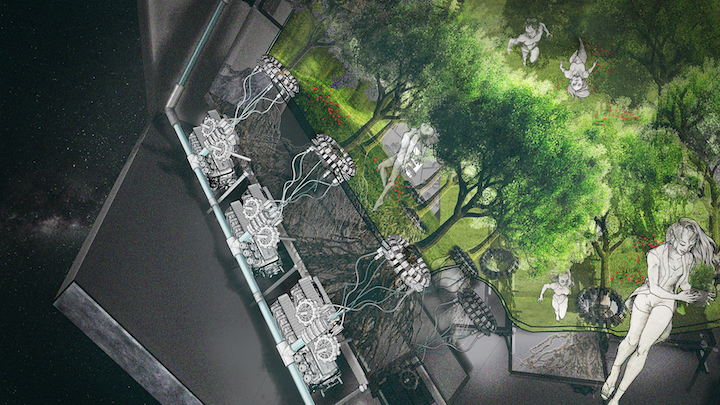7.01.2019

Image by Arise Wan.
Going interstellar is hard. The closest stars to the sun are generally several light-years away, so a trip would take decades at best. Not to mention that the road there is perilous: Particle impacts and radiation can easily destroy a mission on its way there. Angelo Vermeulen, however, likes hard problems. He has imagined a spacecraft dug into an asteroid, which evolves like an organism and could take us beyond the solar system.
The best part? Vermeulen’s project isn’t science fiction but actual scientific research he’s pursuing at the Technical University of Delft in the Netherlands, where he is preparing a computer simulation for the proposed starship. And he isn’t alone. As more countries shoot for the moon and do-it-yourself groups help democratize outer space, the world’s top space agencies and major research universities are going one step further, increasingly turning to adaptive, biomimetic and evolutionary-inspired designs for space exploration. Bio-inspired design, scientists believe, can allow us to design more efficiently and react better to unforeseen problems. That adaptability, experts say, will be key in pushing farther out from Earth.
The European Space Agency (ESA) is studying how organisms like fungi survive in the face of extreme radiation, such as after the Chernobyl nuclear disaster, to better prepare human space flights against ionizing radiation beyond the Earth’s protective magnetic field. At Newcastle University, Rachel Armstrong, a professor and specialist in space architecture who focuses on sustainability and bio-inspired design, is working on Project Persephone, a speculative “earthship” with an entire, organically developed city within it, which will orbit Earth.
BIO-INSPIRED DESIGN IS ABSOLUTELY THE FUTURE.
RAUL POLIT-CASILLAS, NASA SPACE ARCHITECT
Raul Polit-Casillas, a Spanish architect and engineer working at NASA’s elite Jet Propulsion Laboratory, is trying to make select parts of spacecrafts multifunctional, similar to how human body parts function. For instance, he explains, the skin allows us to sense but also helps with thermal management, and so assists in protecting internal body parts from the outside. And at TU Delft, Vermeulen and his colleagues are designing a spacecraft that will feed off an asteroid’s resources and evolve in ways that mimic organisms on Earth.
“Bio-inspired design is absolutely the future,” says Casillas. “Because resources and energy are limited, particularly in space. So repurposing what you have and doing more with less is crucial.”
Outside the world of outer space, bio-inspired design has led to real-world products in the past. Velcro was invented in the 1940s after studying plant seeds. And even in space exploration, the ESA first began biomimetics research in 2003. But it’s only now that those isolated efforts are making way for a growing chorus of interest in learning from biology and nature to design better and more resilient space missions. “Currently it’s not mainstream,” says Katharina Hildebrandt, an ESA researcher who specializes in biomimetics. “But I think it’s expanding much more. It’s in the heads of more engineers.”
For sure, biologically inspired design has its limitations and will probably not be able to completely replace traditional engineering. “Biomimetics is good, but it’s not always the best solution,” says Dario Izzo, scientific coordinator of the ESA Advanced Concepts Team that looks at future technologies. In his view, future spacecraft would have a combination of bio-inspired parts and traditionally engineered parts. “We still do some things much better than what nature was able to develop,” he adds.
Vermeulen recognizes that “you can’t design an entire rocket this way” but sees great promise in designs inspired by evolution. He calls it bottom-up design because it produces unexpected results on its own. “Evolution is a very strong optimization procedure,” he says. “And we can use its power to produce systems that are more resilient and can handle a broader range of challenges.” That’s critical for interstellar missions. He points out how the Apollo program didn’t directly take man to the moon. “We always came back to Earth to revise and learn,” he says. “In interstellar trips, that’s not possible, and we will encounter challenges we cannot predict.”
(The above video is a depiction of the starship project Angelo Vermeulen is working on, with a satellite drawing on an asteroid for resources. Credit: Joris Putteneers)
Already, bio-inspired space architecture is finding its way into reality. Casillas’ work, for instance, is being used in active NASA projects, “but I’m not allowed to say which,” he says.
And beyond pure design challenges, bio-inspired spacecraft can also allow mankind to think beyond “existing conventions,” says Armstrong of Newcastle University, and that then “raises questions about how we inhabit this planet.” The speculative city that the spaceship she has designed will host won’t be built like terrestrial urban hubs but would grow from the bottom up in an organic fashion based on the needs of its inhabitants. “We are thinking about what it means to inhabit space in an age of ecology, as opposed to an age of industry,” Armstrong says. Unlike traditional conversations about asteroid mining and space “colonization” that she describes as industrial in character, future settlements in other worlds “will need to be mindful of the impact of our settlement.”
“That is why we need biological thinking about human space inhabitation,” she says.
Back at TU Delft, Vermeulen knows his interstellar spaceship won’t be built anytime soon. But the speed at which the design concepts drawn from nature that he is using are gaining traction suggests we’ll eventually see bio-inspired spacecraft floating out from Earth. “As humans, it’s hard to step outside of our own time,” says Vermeulen. “It’s really difficult to see into the future. But that’s exactly why I do it.”
Quelle: OZY
